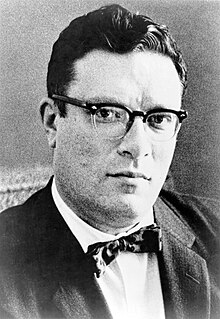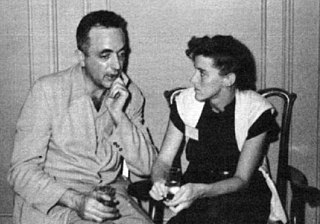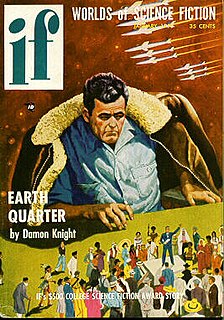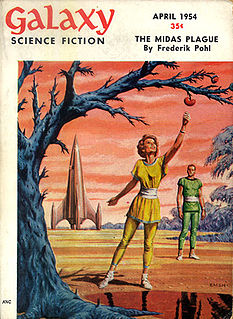Related Research Articles

Alfred Elton van Vogt was a Canadian-born science fiction author. His fragmented, bizarre narrative style influenced later science fiction writers, notably Philip K. Dick. He is one of the most popular and influential practitioners of science fiction in the mid-twentieth century, the genre's so-called Golden Age, and one of the most complex.

Catherine Lucille Moore was an American science fiction and fantasy writer, who first came to prominence in the 1930s writing as C. L. Moore. She was among the first women to write in the science fiction and fantasy genres, though earlier woman writers in these genres include Clare Winger Harris, Greye La Spina, and Francis Stevens, amongst others. Nevertheless, Moore's work paved the way for many other female speculative fiction writers.

Isaac Asimov was an American writer and professor of biochemistry at Boston University. He was known for his works of science fiction and popular science. Asimov was a prolific writer who wrote or edited more than 500 books and an estimated 90,000 letters and postcards. His books have been published in 9 of the 10 major categories of the Dewey Decimal Classification.

Katherine Anne MacLean was an American science fiction author best known for her short fiction of the 1950s which examined the impact of technological advances on individuals and society.

Laurence van Cott Niven is an American science fiction writer. His best-known works are Ringworld (1970), which received Hugo, Locus, Ditmar, and Nebula awards, and The Mote in God's Eye (1974). The Science Fiction and Fantasy Writers of America named him the 2015 recipient of the Damon Knight Memorial Grand Master Award. His work is primarily hard science fiction, using big science concepts and theoretical physics. It also often includes elements of detective fiction and adventure stories. His fantasy includes the series The Magic Goes Away, rational fantasy dealing with magic as a non-renewable resource.

Damon Francis Knight was an American science fiction author, editor and critic. He is the author of "To Serve Man", a 1950 short story adapted for The Twilight Zone. He was married to fellow writer Kate Wilhelm.
Lester del Rey was an American science fiction author and editor. He was the author of many books in the juvenile Winston Science Fiction series, and the editor at Del Rey Books, the fantasy and science fiction imprint of Ballantine Books, along with his fourth wife Judy-Lynn del Rey.

Robert Silverberg is an American author and editor, best known for writing science fiction. He is a multiple winner of both Hugo and Nebula Awards, a member of the Science Fiction and Fantasy Hall of Fame, and a Grand Master of SF. He has attended every Hugo Awards ceremony since the inaugural event in 1953.

Yuki-onna is a spirit or yōkai in Japanese folklore. Her character is often depicted in Japanese literature, films, or animation.
"Common Time" is a science fiction short story by American writer James Blish. It first appeared in the August 1953 issue of Science Fiction Quarterly and has been reprinted several times: in the 1959 short-story collection Galactic Cluster; in The Testament of Andros (1965); in The Penguin Science Fiction Omnibus (1973); and in Isaac Asimov Presents the Great SF Stories.
Orbit was an American long-running series of anthologies of new fiction edited by Damon Knight, often featuring work by such writers as Gene Wolfe, Joanna Russ, R. A. Lafferty, and Kate Wilhelm, who was married to Knight. The anthologies tended toward the avant-garde edge of science fiction, but by no means exclusively; occasionally the volumes would feature some nonfiction critical writing or humorous anecdotes by Knight. Inspired by Frederik Pohl's Star Science Fiction series, and in its turn an influence on Harlan Ellison's Dangerous Visions volumes and many others, it ran for over a decade and twenty-one volumes, not including a "Best-of" collection which covered the years 1966-1976.

The Last Theorem is a 2008 science fiction novel by Arthur C. Clarke and Frederik Pohl. It was first published in the United Kingdom by HarperVoyager in July 2008, and in the United States by Del Rey Books in August 2008. The book is about a young Sri Lankan mathematician who finds a short proof of Fermat's Last Theorem, while an alien invasion of Earth is in progress.

"Special Delivery" is a science fiction short story by American writer Damon Knight. It first appeared in the April 1954 issue of Galaxy Science Fiction and has been reprinted a number of times, in Operation Future (1955), Far Out (1961), and The Best of Damon Knight (1976).
"Not with a Bang" is a science fiction short story by American writer Damon Knight. It first appeared in the winter 1949 issue of The Magazine of Fantasy and Science Fiction and has been reprinted a number of times, including in Far Out (1961), The Best of Damon Knight (1976), 50 Short Science Fiction Tales, and The Eureka Years (1982).

"Time Enough" is a science fiction short story by American writer Damon Knight. It first appeared in the July 1960 issue of Amazing magazine and has since been reprinted twice, in Far Out (1961) and The Best of Damon Knight (1976).
"The Enemy" is a science fiction short story by American writer Damon Knight. It first appeared in the January 1958 issue of Venture magazine and has been reprinted twice, in the books Far Out (1961) and The Best of Damon Knight (1976).

"Abercrombie Station" is a science fiction short story by American author Jack Vance. It first appeared in the February 1952 issue of Thrilling Wonder Stories. It is about a young woman hired to seduce a wealthy heir to a luxury space station-resort. On her arrival at the space station, she discovers lies, moral turpitude, and betrayal. In 1965, it was retitled "Monsters in Orbit" and published in an Ace Double edition. In 1976 it was reprinted, with the original title, in The Best of Jack Vance. Most recently, it appeared in Hard Luck Diggings: The Early Jack Vance, published in 2010 by Subterranean Press.
"The Women Men Don't See" is a science fiction novelette by American writer Alice Bradley Sheldon, published under the pseudonym James Tiptree, Jr.

Cosmic Stories and Stirring Science Stories were two American pulp science fiction magazines that published a total of seven issues in 1941 and 1942. Both Cosmic and Stirring were edited by Donald A. Wollheim and launched by the same publisher, appearing in alternate months. Wollheim had no budget at all for fiction, so he solicited stories from his friends among the Futurians, a group of young science fiction fans including James Blish and C. M. Kornbluth. Isaac Asimov contributed a story, but later insisted on payment after hearing that F. Orlin Tremaine, the editor of the competing science fiction magazine Comet, was irate at the idea of a magazine that might "siphon readership from magazines that paid", and thought that authors who contributed should be blacklisted. Kornbluth was the most prolific contributor, under several pseudonyms; one of his stories, "Thirteen O'Clock", published under the pseudonym "Cecil Corwin", was very successful, and helped to make his reputation in the field. The magazines ceased publication in late 1941, but Wollheim was able to find a publisher for one further issue of Stirring Science Stories in March 1942 before war restrictions forced it to close again.
References
- ↑ Index to Science Fiction Anthologies and Collections
- ↑ Knight, Damon (1976), The Best of Damon Knight , Nelson Doubleday, New York